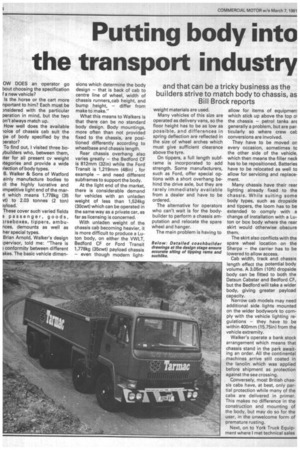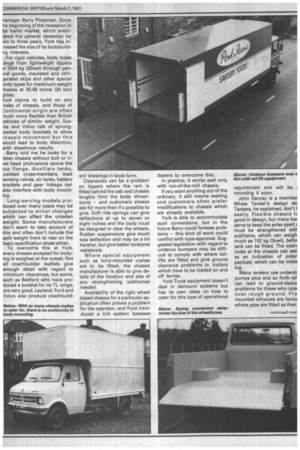Putting body into the transport industry
Page 36

Page 37

Page 38

If you've noticed an error in this article please click here to report it so we can fix it.
OW DOES an operator go bout choosing the specification ía new vehicle?
Is the horse or the cart more nportant to him? Each must be ansidered with the particular peration in mind, but the two an't always match up.
How well does the available loice of chassis cab suit the pe of body specified by the aerator?
To find out, I visited three bo(builders who, between them, iter for all present cv weight itegories and provide a wide )lection of body types.
B. Walker & Sons of Watford ainly manufacture bodies to iit the highly lucrative and )mpetitive light end of the marrt which means 1,778kg (35 vt) to 2.03 tonnes (2 ton) These cover such varied fields s passenger, goods, arseboxes, tippers, ambunces, demounts as well as her special types.
Brian Arnold, Walker's design Ipervisor, told me: "There is ) conformity between different akes. The basic vehicle dimen sions which determine the body design — that is back of cab to centre line of wheel, width of chassis runners,cab height, and bump height, — differ from make to make."
What this means to Walkers is that there can be no standard body design. Body mountings, more often than not provided fixed to the chassis, are positioned differently according to wheelbase and chassis length.
Rear chassis overhang also varies greatly — the Bedford CF is 812mm (321n) while the Ford Transit is 1,219mm (48in) , for example — and need different subframes to support the body.
At the light end of the market, there is considerable demand for vehicles with an unladen weight of less than 1,524kg (30cwt) which can be operated in the same way as a private car, as far as licensing is concerned.
With unladen weight of the chassis cab becoming heavier, it is more difficult to produce a Luton body, on either the VWLT, Bedford CF or Ford Transit 1,778kg (35cwt) payload chassis — even though modern light
weight materials are used.
Many vehicles of this size are operated as delivery vans, so the floor height has to be as low as possible, and differences in spring deflection are reflected in the size of wheel arches which must give sufficient clearance above the tyre.
On tippers, a full length subframe is incorporated to add strength. Some manufacturers, such as Ford, offer special options with a short overhang behind the drive axle, but they are rarely immediately available from a dealer and have to be ordered.
The alternative for operators who can't wait is for the bodybuilder to perform a chassis amputation and relocate the spare wheel and hanger.
The main problem is having to allow for items of equipmem which stick up above the top ol the chassis — petrol tanks arE generally a problem, but are par. ticularly so where crew cal: conversions are involved.
They have to be moved or every occasion, sometimes to the other side of the vehicle, which then means the filler neck has to be repositioned. Batteries have to be relocated as well to allow for servicing and replacement.
Many chassis have their rear lighting already fixed to the chassis. While suiting some body types, such as dropside and tippers, the loom has to be extended to comply with a change of installation with a Luton or box body where the rear skirt would otherwise obscure them.
The skirt also conflicts with the spare wheel location on the Sherpa — the carrier has to be lowered to allow access.
Cab width, track and chassis length effect the potential body volume. A 3.05m (10ft) dropside body can be fitted to both the Datsun Cabstar and Bedford CF, but the Bedford will take a wider body, giving greater payload capacity.
Narrow cab models may need additional side lights mounted on the wider bodywork to comply with the vehicle lighting regulations — they have to be within 400mm (15.75in) from the vehicle extremity.
Walker's operate a bank stock arrangement which means that chassis stand in the park awaiting an order. All the continental machines arrive still coated in the lanolin which was applied before shipment as protection against the sea crossing.
Conversely, most British chassis cabs have, at best, only partial protection while many of the cabs are delivered in primer. This makes no difference in the construction and mounting of the body, but may do so for the user, in the unwelcome form of premature rusting.
Next, on to York Truck Equipment where I met technical sales nanager Barry Plowman. Since he beginning of the recession in he trailer market, which anticirated the general recession by wo to three years, York has inTeased the size of its bodybuildng interests.
For rigid vehicles, body types .ange from lightweight tippers It 1524 kg (30cwt) through gen?ral goods, insulated and refrilerated skips and other special )ody types for maximum weight thassis at 30.48 tonne (30 ton) }ross.
l'ork claims to build on any make of chassis, and those of :ontinental origin are often much more flexible than British vehicles of similar weight. Scalia and Volvo talk of sprungoaded body brackets to allow chassis movement but this would lead to body distortion, with disastrous results.
Barry told me he looks for a :s.lean chassis without bolt or rivet head protrusions above the top flange. Auxiliary tanks, ;:ranked cross-members, load sensing valves, air tanks, battery brackets and gear linkage can also interfere with body mounting.
Long-serving models produced over many years may be subjected to minor changes which can affect the unladen weight. Some manufacturers don't seem to take account of, this and often don't include the split weight front to rear on the basic specification sheet either.
To overcome this at York, every chassis accepted for bodying is weighed at the outset. Not all coachbuilder leaflets give enough detail with regard to minimum clearances, but some, such as Bedford who have produced a booklet for its TL range, are very good. Leyland, Ford and Volvo also produce coachbuild ers' drawings in book form.
Clearances can be a problem on tippers where the ram is fitted behind the cab and chassis lengths limit the body dimensions — and customers always ask for more than it's possible to give. Soft ride springs can give deflections at up to seven or eight inches and the body must be designed to clear the wheels. Rubber suspensions give much less deflection and may be a bit harsher, but give better torsional resistance.
Where special equipment such as lorry-mounted cranes are to be fitted, the chassis manufacturer is able to give details of the location and size of any strengthening subframes needed.
Availability of the right wheel based chassis for a particular application often proves a problem for the operator, and Ford introduced a link system between dealers to overcome this.
In practice, it works well only with run-of-the-mill chassis.
If you want anything out of the ordinary, it still means waiting and customers often prefer modifications to chassis which are already available.
York is able to accommodate such conversions, but in the future Barry could foresee problems — this kind of work could conflict with type-approval. Suggested legislation with regard to underun bumpers may be difficult to comply with where taillifts are fitted and give ground clearance problems to trailers which have to be loaded on and off ferries.
York Truck equipment doesn't deal in demount systems but has its own ideas on how to cater for this type of operational requirement and will be ; nouncing it soon.
John Darney is a member Whale Tanker's design teC Tankers, he explained, don't f easily. Flexible chassis lc good in design, but many bar serve to keep the axles apart E must be strengthened witlsubframe, which can weigh much as 152 kg (3cwt), befor tank can be fitted. The operE looks at the chassis cab wei as an indication of poten payload, which can be misle ing.
Many tankers use undersli pumps ptos and so forth wf can lead to ground-cleara problems for those who oper over rough ground. Fro mounted exhausts are favou where ptos are fitted as then ipe need not be re-routed to ive clearance to the pto outlet 1 the gearbox.
In common with other manucturers Whale finds that auxilry equipment must often be loved. Air tanks are a regular ?.m which have to be moved am the inside to the outside of e chassis to make way for .os. John was also aware of the .nding pitfalls regarding type)proval, which will come into fect in October, 1982.
If under-run protection be)mes a requirement Whale nkers, many of which are degned to carry various forms of aste, will need two types of ar-end protection as tank proction is already specified.
Manufacturers chassis mount-points are are not used. Instead, ith fixed and tipper tanks use ree mounting point each 304.8 457.2mm (12 or 18 inches ig) on each side.
Subframes have to be made to etch splayed chassis where per tanks are fitted. Even qugh tank sizes and weight 5tribution are calculated by mputer to suit various makes d sizes of chassis, engineering erances throw a spanner in works making tank manufac-e not quite as simple as it ght at first appear.
John explained further. "As iponsible manufacturers we ve to design each vehicle to minimise overloading. A tipper can be designed to suit a payload of nominal density, but as the actual load may be heavier or lighter much of the weight control is left to the driver."
Moreover, densities of liquids vary much less than solids — in extreme cases it could be as much as between 7 to 18 lb/gall but most of the more common commodities fall around the 10 lb/gall mark.
It follows, then, that the tank capacity is much more closely defined. When it is full it is expected to at maximum weight.
The quoted chassis weight added to the estimated weight of the equipment and subtracted from the gross vehicle weight gives a figure for the tank and payload; but chassis cab weights vary by as much as ±2.5 per cent, and on a typical 16-ton
chassis this could mean a difference of over 226.8 kg (500 lb). Pump gear, valves and so forth have a similar manufacturing tolerance which in practice could vary by as much as 49.9 kg (110 lb).
Then onto the tank itself. Whale use steel produced to BSS 4360 which has a weight tolerance of five per cent. So a tank still calculated to weigh 1,100kg (2,400 lb) could weigh as little as 1,045 kg (2,280 lb) or as much as 1,155kg (2,520 lb).
Manufacturing tolerances of only one-fifth of one per cent on diameter and one-third of one per cent on length may mean the difference of ± a further 58.9 kg (130 lb) of payload.
With all the pluses and minuses going in opposite directions it could mean that two nominally identical 9,072 litre (2,000 gallon) tanker vehicles, designed for 16-ton gross, full to capacity, might vary by as much as almost 762 kg (0.75 ton). With heavier gwv vehicles it could be a lot worse.
So many vehicles are delivered in primer and show the signs of being stood up for a long time. Few are accompanied by an itinery of loose equipment such as spare wheels, jacks, tool rolls and so on.
John would like to see better storage facilities included in the cab for drivers' effects and equipment, and provision made to fit controls for pumps and such like inside the cab.
























































































































